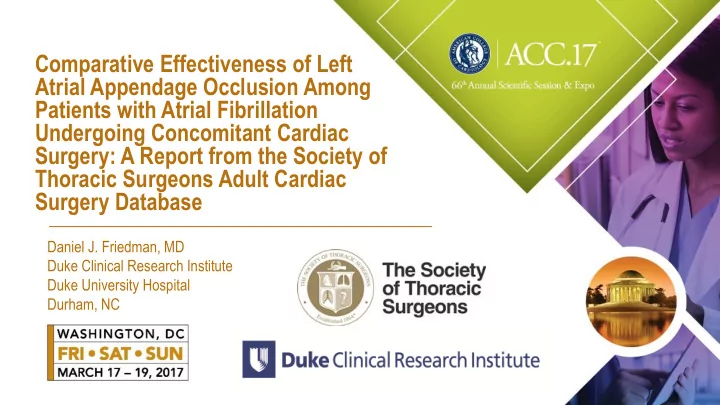

Comparative Effectiveness of Left Atrial Appendage Occlusion Among Patients with Atrial Fibrillation Undergoing Concomitant Cardiac Surgery: A Report from the Society of Thoracic Surgeons Adult Cardiac Surgery Database Daniel J. Friedman, MD Duke Clinical Research Institute Duke University Hospital Durham, NC
Co-authors Jonathan P. Piccini, MD, MHS; Tongrong Wang, MS; S. Chris Malaisrie, MD; David R. Holmes MD; Rakesh M. Suri, MD, DPhil; Michael J. Mack, MD; Vinay Badhwar, MD; Jeffrey P. Jacobs, MD; Jeffrey G. Gaca, MD; Shein-Chung Chow, PhD; Eric D. Peterson, MD, MPH; J. Matthew Brennan, MD, MPH
Background • The left atrial appendage (LAA) is implicated as the site of thrombus formation in 90% of thromboembolic (TE) events among patients with non-rheumatic atrial fibrillation (AF) • Although systemic oral anticoagulation reduces the risk of TEs, as few as half of all eligible patients take these medications • The LAA can be surgically occluded at the time of cardiac surgery (S-LAAO) although there are limited data supporting the effectiveness of this procedure Blackshear and Odell Ann Thorac Surg . 1996;61(2):755 – 759 Hsu JC et al JAMA Cardiol . 2016;1(1):55 – 62
Objective • To perform a large comparative effectiveness analysis of S- LAAO in a contemporary, nationally representative cohort of Medicare beneficiaries with AF who underwent cardiac surgery in the United States • Primary outcome – Re-hospitalization for thromboembolism (ischemic stroke, TIA, systemic embolism) at 1 year • Secondary outcomes – Hemorrhagic stroke, all-cause mortality, and a composite endpoint consisting of all-cause mortality, thromboembolism, and hemorrhagic stroke
Methods – Data Sources • Society of Thoracic Surgeons (STS) Adult Cardiac Surgery Database from 2011-2012 – >1,000 participating institutions – ~90% of CT surgical programs in the US • A validated deterministic linkage process allowed for ascertainment of longitudinal data on morbidity and mortality for those with fee-for-service Medicare Jacobs JP et al Ann Thorac Surg . 2016;101(1):33 – 41 Jacobs JP et al Ann Thorac Surg . 2010;90(4):1150 – 1156
Methods • Inclusions • Exclusions – ≥65 years linked to – Missing data on S-LAAO, primary Medicare claims surgical procedure, or discharge – AF or atrial flutter anticoagulation – First time cardiac surgery – Cardiogenic shock – Operations – Off pump operations • CABG – Operations for endocarditis, combined • Mitral valve surgery ± aortic and mitral disease, congenital CABG heart disease, transplant, ventricular • Aortic valve surgery ± CABG assist device implantation – ≥6 months of follow -up after discharge
Statistical Methods • Inverse probability weighted Cox proportional hazards models or Fine-Gray models – 29 variables were used for adjustment • Exploratory secondary analyses with stratification by discharge anticoagulation
Results • 10,524 patients met study criteria • Median age 76, interquartile range (IQR) 71-81 • 39% female • Median CHA 2 DS 2 -VASc 4, IQR 3-5 • Primary operation – 30% mitral valve procedure ± CABG (n=3,162) – 35% aortic valve procedure ± CABG (n=3,635) – 35% isolated CABG (n=3,726) • 37% underwent S-LAAO (n=3,892)
Baseline Characteristics by Treatment Characteristic No S-LAAO S-LAAO P-Value N=6,632 N=3,892 Age, years 76.4 (6.4) 75.0 (5.9) <0.0001 Female, % 37.6 40.2 0.0065 Paroxysmal AF, % 50.5 43.4 <0.0001 CHF, % 44.4 45.8 0.15 Prior Stroke, % 15.0 13.7 0.07 CHADSVASC, % 4.1(1.4) 3.9(1.4) <0.0001 STS Risk Score <5% 62.0 72.4 <0.0001 5-9% 24.9 19.8 10+% 13.0 7.8
Baseline Characteristics by Treatment Characteristic No S-LAAO S-LAAO P-Value N=6,632 N=3,892 Age, years 76.4 (6.4) 75.0 (5.9) <0.0001 Female, % 37.6 40.2 0.0065 Paroxysmal AF, % 50.5 43.4 <0.0001 CHF, % 44.4 45.8 0.15 Prior Stroke, % 15.0 13.7 0.07 CHADSVASC, % 4.1(1.4) 3.9(1.4) <0.0001 STS Risk Score <5% 62.0 72.4 <0.0001 5-9% 24.9 19.8 10+% 13.0 7.8
Thromboembolism 1.6% vs. 2.5% Unadjusted HR 0.63, CI 0.47-0.84, p=0.0016 Adjusted HR 0.62, CI 0.46-0.83, p=0.001
All-cause mortality 7.0% vs. 10.8% Unadjusted HR 0.63, CI 0.55-0.73, p<0.0001 Adjusted HR 0.85, CI 0.74-0.97, p=0.015
Hemorrhagic Stroke 0.2% vs. 0.3% Unadjusted HR 0.70, CI 0.29-1.69, p=0.43 Adjusted HR 0.64, CI 0.26-1.56, p=0.33
TE, Hemorrhagic Stroke, or Death 8.7% vs. 13.5% Unadjusted HR 0.63, CI 0.55-0.71, p<0.0001 Adjusted HR 0.70, CI 0.70-0.90, p=0.0002
Outcomes by Discharge Anticoagulation No Anticoagulation (n=3,848) Anticoagulation (n=6,676)
Results Summary • S-LAAO was associated with a 38% lower risk of thromboembolism and 15% lower risk of all-cause mortality • Exploratory analyses suggest that the association between S-LAAO and a lower rate of thromboembolism is strongest among those discharged without oral anticoagulation
Limitations • Retrospective, non-randomized study design • Endpoints determined by ICD-9 codes • No data on method or completeness of S-LAAO • Discharge anticoagulation status may not be predictive of long term anticoagulant use
Conclusions • In a nationally representative cohort of older patients with AF undergoing cardiac surgery, S-LAAO was associated with lower rates of thromboembolism and all-cause mortality • Although randomized trial data are needed, these data support the use of S-LAAO among patients with AF undergoing cardiac surgery
Funding • Regulatory Science Award from Burroughs Welcome Fund (Brennan) • Food and Drug Administration grant 1U01FD004591-01 (Brennan) • National Institutes of Health T 32 training grant HL069749- 13 (Friedman)
Recommend
More recommend